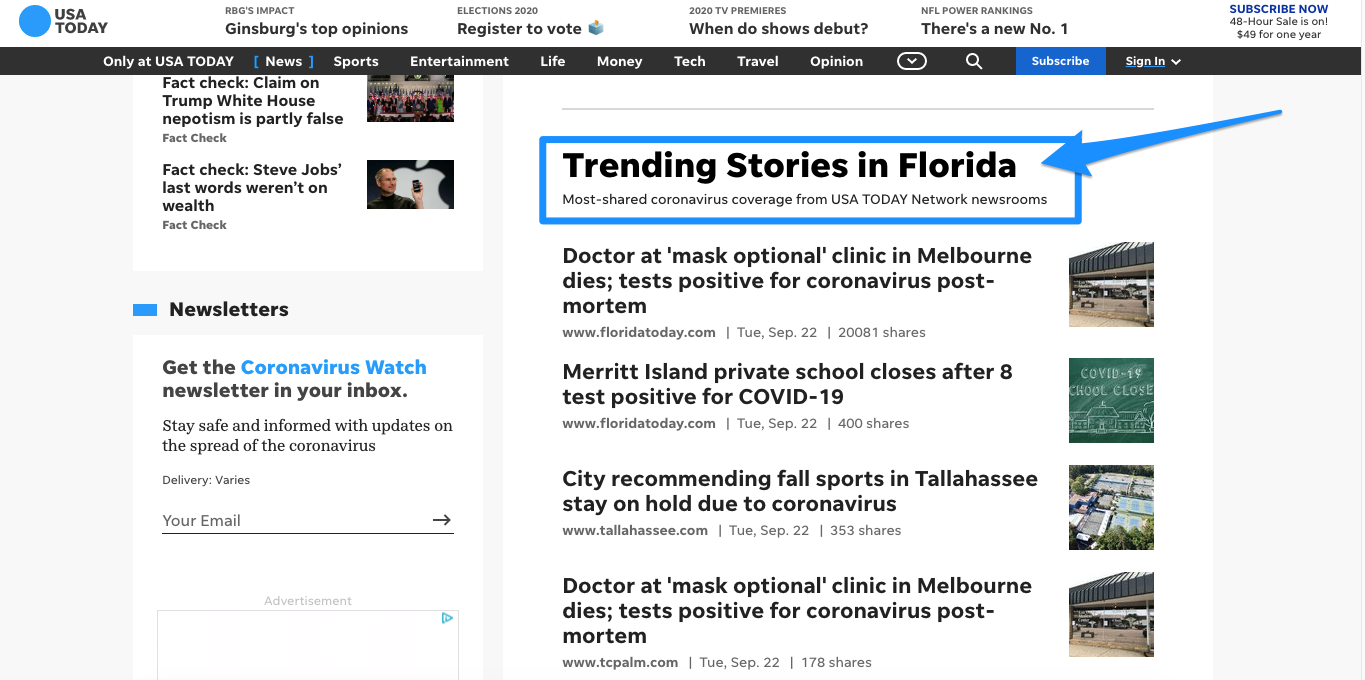How Gannett Standardized Content Analytics for 600+ Publications

When Gannett merged with Gatehouse Media in 2019, they faced the challenge of standardizing systems and processes as the two groups became one. A top priority in the wake of the merger was to determine a consistent way to measure content performance for hundreds of publications.
Gannett decided to adopt Parse.ly across their entire editorial team so that everyone could speak the same language about content.
We sat down with Josh Awtry, Gannett’s VP of Content Strategy, to learn the ways Parse.ly eased the acquisition transition and allows Gannett to stay agile into the future.
Table of Contents
Consistent content reporting across 600+ publications
Working within a two-week deadline dictated by the merger agreement, Gannett needed to unify content reporting across the hundreds of publications their organization managed. With legacy content management systems and staff across almost all 50 states, Josh saw using the same data, terminology, and KPIs to communicate seamlessly as critical for the unification process.
“Starting that shared vocabulary was important…it’s important our newsrooms understand the importance of these blended engagement metrics,” he explained.
Gannett knew they needed to become more data-driven in their editorial processes. Their goal was to build a team of journalists who coupled newsroom knowledge with data science. That’s where Parse.ly came in.
“This notion that a journalist today has to do everything is true, but they have to focus on getting news to people and not crunching numbers,” Josh said.
“One of the things Parse.ly provides is that you can spend just 10 minutes of training and get the basics of how to use it. For our journalists out there in the field, doing that important work every day, Parse.ly can quickly surface insights. But on the other side of the coin, Parse.ly is powerful enough and deep enough to be a serious contender in heavy-hitting data-crunching and analysis.
“Every media outlet has data analysts, consumer insights. But no organization has really gotten the hang of how to combine journalism and data. Parse.ly really blends those two crafts for us.”
Custom solution for personalized content recommendations
To serve relevant, timely content to their country-wide audience, Gannett needed to personalize readers’ on-site experiences based on their geography. They used Parse.ly’s content personalization functionality, powered by our API, to create a “Trending Stories in [location]” module. It lives at the bottom of the page on various Gannett publication websites, and promotes recirculation and deeper audience engagement.

Source: USA Today
They also use this type of geographical segmentation within Parse.ly to decide when to give stories from their local news sites a boost.
“For us, an analytics solution that says, ‘Hey, your story got 5,000 page views on this website,’ leaves so many unanswered questions,” Josh said. “Parse.ly’s intelligence gives us the insights we need to figure out whether local content needs to be elevated to a national stage.”
True audience engagement measurement
Gannett’s decision to unite their editorial teams with Parse.ly illustrates their dedication to measuring audience engagement in a modern, forward-thinking way. They’re especially focused on engaged-time because, as Josh noted, “It’s not about how many page views you can get, and it’s not about how many photo galleries you can publish for page visits to look good on a report.”
“The news industry has smartly pivoted away from volume and moved toward engagement metrics. Parse.ly was early to the engaged-time metric. Now, they’re helping us target loyal readers and get more into subscriptions.”
Gannett’s editorial team also uses Parse.ly to optimize their posts on social media in real-time. They dial into referral traffic sources to identify trends and track which articles are taking off so they can boost them to maximize exposure.
“Real-time analysis and in-the-moment thinking, where an hour of delay changes the nature of the ball game and how that content resonates with the audience, is crucial,” said Josh.
Preparing for industry disruptions
True audience engagement metrics will become even more important for Josh and his team with the discontinuation of the third-party cookie in 2022. “We have been given the gift of this ticking clock,” he said. “We have two years or less to fully pivot our entire business, and in some sense, an industry, towards focusing on audience that matters—and not how much audience we can get.
“Parse.ly has given us a speed and flexibility that we wouldn’t have if we were still using our homegrown solutions,” said Josh. “It has provided the technical boost that we needed to match our cultural speed.”
Unlike other analytics platforms, Parse.ly is designed specifically for editorial and content teams, large and small. Whether you’re uniting hundreds of journalists under one source of truth, or getting a one-person content marketing engine up and running, our solution will help you get the job done. Reach out today to get a personal demo from our team of content analytics experts and see for yourself.
Want to hear more about how Gannett is using Parse.ly? Make sure to read the full version of our conversation with Josh.